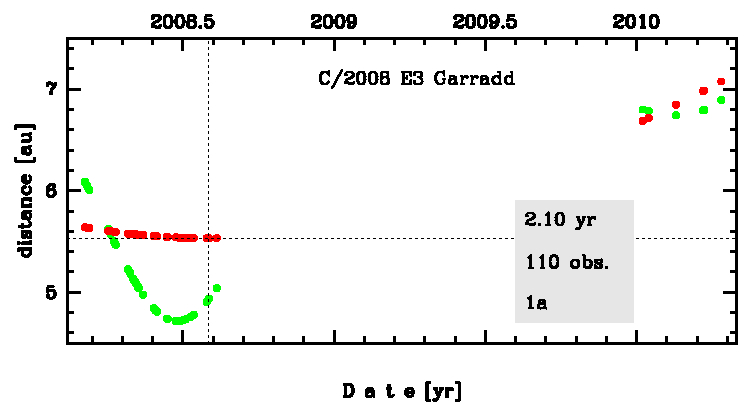C/2008 E3 Garradd
more info
C/2008 E3 was discovered on 5 March 2008 by Gordon J. Garradd (Siding Spring), that is about 5 months before its perihelion passage. In was observed until mid-April 2010.
This comet made its closest approach to the Earth on 24 June 2008 (4.715 au), about 3.5 months after its discovery.
Solutions given here are based on data spanning over 2.10 yr in a range of heliocentric distances: 5.64 au – 5.531 au (perihelion) – 7.07 au.
This comet (original semimajor axis of about 7,000 au) suffers moderate planetary perturbations during its passage through the planetary system; these perturbations lead to a more tight future orbit with semimajor axis of about 1,350 au.
This comet made its closest approach to the Earth on 24 June 2008 (4.715 au), about 3.5 months after its discovery.
Solutions given here are based on data spanning over 2.10 yr in a range of heliocentric distances: 5.64 au – 5.531 au (perihelion) – 7.07 au.
This comet (original semimajor axis of about 7,000 au) suffers moderate planetary perturbations during its passage through the planetary system; these perturbations lead to a more tight future orbit with semimajor axis of about 1,350 au.
| solution description | ||
|---|---|---|
| number of observations | 110 | |
| data interval | 2008 03 05 – 2010 04 12 | |
| data type | perihelion within the observation arc (FULL) | |
| data arc selection | entire data set (STD) | |
| range of heliocentric distances | 5.64 au – 5.53 au (perihelion) – 7.07 au | |
| detectability of NG effects in the comet's motion | NG effects not determinable | |
| type of model of motion | GR - gravitational orbit | |
| data weighting | YES | |
| number of residuals | 217 | |
| RMS [arcseconds] | 0.50 | |
| orbit quality class | 1a | |
| orbital elements (heliocentric ecliptic J2000) | ||
|---|---|---|
| Epoch | 2008 08 02 | |
| perihelion date | 2008 08 02.20884372 | ± 0.00227753 |
| perihelion distance [au] | 5.53102503 | ± 0.00001045 |
| eccentricity | 0.99853829 | ± 0.00001610 |
| argument of perihelion [°] | 218.092908 | ± 0.000228 |
| ascending node [°] | 105.674986 | ± 0.000028 |
| inclination [°] | 105.076575 | ± 0.000037 |
| reciprocal semi-major axis [10-6 au-1] | 264.27 | ± 2.91 |
